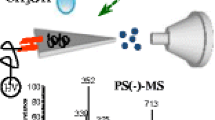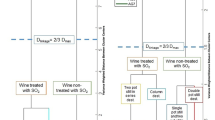Abstract
The rising crime rate associated with document forgery has a significant impact on public safety and social stability. In document fraud cases, determining the origin of a particular stamp-pad ink is the most important objective. In this study, a comprehensive analysis of the volatile compounds in quick-drying stamp-pad inks from six commonly used brands were performed for the first time, utilizing a combination of headspace-gas chromatography-ion mobility spectrometry (HS-GC-IMS) and multivariate statistical analysis methods. Visual and comparative analysis of the differential volatile components among different stamp-pad ink samples was conducted using fingerprints and volcano plots. A total of 127 volatile compounds were accurately identified, with ketones, esters, alcohols, and aldehydes being the most abundant compounds in the stamp-pad inks. Hierarchical clustering analysis (HCA), including dendrograms and clustering heatmaps, was utilized to explore the correlations between these compounds and the samples. Additionally, the precise identification of positional isomers and functional group isomers of aliphatic compounds was achieved. To achieve accurate discrimination of various stamp-pad ink samples, a multivariate statistical analysis method was utilized to establish a classification model for them. Based on the results obtained from HS-GC-IMS, effective discrimination among different brands of stamp-pad ink samples was achieved through principal component analysis (PCA) and orthogonal partial least squares discriminant analysis (OPLS-DA). The model exhibited excellent performance, with the fit index of dependent variables (R2Y) and the predictive index of the model (Q2) values of 0.99 and 0.984, respectively. These results provided significant theoretical evidence for the application of HS-GC-IMS as an efficient technique in the analysis of volatile compounds, identification of positional isomers and functional group isomers, as well as tracing the origin of stamp-pad ink and analyzing the formation time of documents.
Graphical Abstract






Similar content being viewed by others
References
Luo Z, Wang W, Pang X, Zhang J, Sun C, Zhou X, et al. Writing sequence identification of seals and signatures in documents using ambient mass spectrometry imaging with chemometric methods. Talanta. 2021;235: 122804.
Zhou Y, Zheng J, Hu H, Wang Y. Handwritten signature verification method based on improved combined features. Appl Sci. 2021;11(13):5867.
Teixeira CA, Poppi RJ. Discriminating blue ballpoint pens inks in questioned documents by Raman imaging and mean-field approach independent component analysis (MF-ICA). Microchem J. 2019;144:411–8.
Su D, Li K. Micro Raman spectroscopy combined with chromatographic effect and OPLS-DA for time-resolved detection of stamp inks. Microchem J. 2023;190: 108727.
Tao Y-M, Tang H, Yang X, Chen X-H. Assessment of high-quality counterfeit stamp impressions generated by inkjet printers via texture analysis and likelihood ratio. Forensic Sci Int. 2023;344: 111573.
Takalo J, Timonen J, Sampo J, Rantala M, Siltanen S, Lassas M. Using the fibre structure of paper to determine authenticity of the documents: analysis of transmitted light images of stamps and banknotes. Forensic Sci Int. 2014;244:252–8.
Hoehse M, Paul A, Gornushkin I, Panne U. Multivariate classification of pigments and inks using combined Raman spectroscopy and LIBS. Anal Bioanal Chem. 2012;402(4):1443–50.
Ouyang G, Li B, Zhao P, Guo X, Wang C. Preliminary studies on the absorbance ratio method used to determining the age of stamp-pad ink seal. J Forensic Sci. 2019;64(4):1203–12.
Ni Y, He N, Lü Y, Zou N, Song H, Li H, et al. Study of ink aging: targeting triethylene glycol in carbon-based black gel ink strokes on paper. Forensic Sci Int. 2020;311: 110296.
Fournier R, Shum AD, Liu J, Sabarirajan DC, Xiao X, Zenyuk IV. Combined infrared thermography, X-ray radiography, and computed tomography for ink drying studies. ACS Appl Energy Mater. 2018;1(11):6101–14.
MohamadAsri MN, Verma R, Mahat NA, Nor NAM, Mat Desa WNS, Ismail D. Discrimination and source correspondence of black gel inks using Raman spectroscopy and chemometric analysis with UMAP and PLS-DA. Chemom Intell Lab Syst. 2022;225: 104557.
Kurouski D, Zaleski S, Casadio F, Van Duyne RP, Shah NC. Tip-enhanced Raman spectroscopy (TERS) for in situ identification of indigo and iron gall ink on paper. J Am Chem Soc. 2014;136(24):8677–84.
Shen H, Rösch P, Popp J. Fiber probe-based Raman spectroscopic identification of pathogenic infection microorganisms on agar plates. Anal Chem. 2022;94(11):4635–42.
Lian Z, Yang R, Zhao L, Shi G, Liang L, Qin D, et al. Analysis of volatile components in inkjet printouts by GC–MS: a classification method. Forensic Sci Int. 2021;318: 110562.
Onat B, Rosales-Solano H, Ferrier L, Pawliszyn J. Identification of the metabolites regulated in soybean-Rhizobia symbiosis through solid phase microextraction coupled with LC-MS. J Chromatogr A. 2021;1641: 461934.
Liu Y, Qian X, Xing J, Li N, Li J, Su Q, et al. Accurate determination of 12 lactones and 11 volatile phenols in nongrape wines through headspace-solid-phase microextraction (HS-SPME) combined with high-resolution gas chromatography-Orbitrap mass spectrometry (GC-Orbitrap-MS). J Agric Food Chem. 2022;70(6):1971–83.
An Y, Wen L, Li W, Zhang X, Hu Y, Xiong S. Characterization of warmed-over flavor compounds in surimi gel made from silver carp (Hypophthalmichthys molitrix) by gas chromatography–ion mobility spectrometry, aroma extract dilution analysis, aroma recombination, and omission studies. J Agric Food Chem. 2022;70(30):9451–62.
Feng T, Sun J, Wang K, Song S, Chen D, Zhuang H, et al. Variation in volatile compounds of raw Pu-Erh tea upon steeping process by gas chromatography–ion mobility spectrometry and characterization of the aroma-active compounds in tea infusion using gas chromatography–olfactometry–mass spectrometry. J Agric Food Chem. 2022;70(42):13741–53.
Xing Y, Yu Z, Hu X, Yin J, Fan T, Fu Z, et al. Characterization of volatile organic compounds in Polygonum multiflorum and two of its processed products based on multivariate statistical analysis for processing technology monitoring. J Chromatogr A. 2022;1680: 463431.
Dodds JN, Hopkins ZR, Knappe DRU, Baker ES. Rapid characterization of per- and polyfluoroalkyl substances (PFAS) by ion mobility spectrometry–mass spectrometry (IMS-MS). Anal Chem. 2020;92(6):4427–35.
Daulton E, Wicaksono AN, Tiele A, Kocher HM, Debernardi S, Crnogorac-Jurcevic T, et al. Volatile organic compounds (VOCs) for the non-invasive detection of pancreatic cancer from urine. Talanta. 2021;221: 121604.
Vautz W, Seifert L, Mohammadi M, Klinkenberg IAG, Liedtke S. Detection of axillary perspiration metabolites using ion mobility spectrometry coupled to rapid gas chromatography. Anal Bioanal Chem. 2020;412(1):223–32.
Liu Q, Li S, Li Y, Yu L, Zhao Y, Wu Z, et al. Identification of urinary volatile organic compounds as a potential non-invasive biomarker for esophageal cancer. Sci Rep. 2023;13(1):18587.
Gu S, Zhang J, Wang J, Wang X, Du D. Recent development of HS-GC-IMS technology in rapid and non-destructive detection of quality and contamination in agri-food products. TrAC Trends Anal Chem. 2021;144: 116435.
Segura-Borrego MP, Martín-Gómez A, Ríos-Reina R, Cardador MJ, Morales ML, Arce L, et al. A non-destructive sampling method for food authentication using gas chromatography coupled to mass spectrometry or ion mobility spectrometry. Food Chem. 2022;373: 131540.
Lu W, Jiang R, Li X, Qi Y, Ji Z, Lv X, et al. Characterization and discrimination of volatile compounds in gel-pen ink via headspace-gas chromatography-ion mobility spectrometry combined with chemometric strategies. Microchem J. 2022;182: 107855.
Lu W, Chen J, Li X, Qi Y, Jiang R. Flavor components detection and discrimination of isomers in Huaguo tea using headspace-gas chromatography-ion mobility spectrometry and multivariate statistical analysis. Anal Chim Acta. 2023;1243: 340842.
Li Y, Qin Y, Wei S, Ling L, Ding C-F (2023) Differentiation of steroid isomers by steroid analogues adducted trapped ion mobility spectrometry-mass spectrometry. Anal Bioanal Chem. https://doi.org/10.1007/s00216-023-05019-5
Chen C, Yu F, Wen X, Chen S, Wang K, Wang F, et al. Characterization of a new (Z)-3:(E)-2-hexenal isomerase from tea (Camellia sinensis) involved in the conversion of (Z)-3-hexenal to (E)-2-hexenal. Food Chem. 2022;383: 132463.
Iyer S, Rissanen MP, Valiev R, Barua S, Krechmer JE, Thornton J, et al. Molecular mechanism for rapid autoxidation in α-pinene ozonolysis. Nat Commun. 2021;12(1):878.
Chen Y, Jiao L, Yan H, Xu W, Wu Y, Wang H, et al. Hierarchically porous S/N codoped carbon nanozymes with enhanced peroxidase-like activity for total antioxidant capacity biosensing. Anal Chem. 2020;92(19):13518–24.
Wang F, Gao Y, Wang H, Xi B, He X, Yang X, et al. Analysis of volatile compounds and flavor fingerprint in Jingyuan lamb of different ages using gas chromatography–ion mobility spectrometry (GC–IMS). Meat Sci. 2021;175: 108449.
Yun J, Cui C, Zhang S, Zhu J, Peng C, Cai H, et al. Use of headspace GC/MS combined with chemometric analysis to identify the geographic origins of black tea. Food Chem. 2021;360: 130033.
Funding
This work was financially supported by the Natural Science Foundation of Shandong Province (ZR2022QB157, ZR2023QB089, ZR2022QB203); the Open-Fund of Shanghai Key Lab of Forensic Medicine, Key Lab of Forensic Science, Ministry of Justice, China (KF202316); the Scientific Research Project of Shandong University of Political Science and Law (2021Z01B); Youth Innovation Team Development Project of Shandong Universities (2019KJE018); and the Scientific Research Project of Sichuan Medical Law Research Center (YF22-Q16).
Author information
Authors and Affiliations
Corresponding authors
Ethics declarations
Conflict of interest
The authors declare no competing interests.
Additional information
Publisher's Note
Springer Nature remains neutral with regard to jurisdictional claims in published maps and institutional affiliations.
Supplementary Information
Below is the link to the electronic supplementary material.
Rights and permissions
Springer Nature or its licensor (e.g. a society or other partner) holds exclusive rights to this article under a publishing agreement with the author(s) or other rightsholder(s); author self-archiving of the accepted manuscript version of this article is solely governed by the terms of such publishing agreement and applicable law.
About this article
Cite this article
Qi, Y., Lv, X., Ma, J. et al. Volatile-compound fingerprinting and discrimination of positional isomers in stamp-pad ink tracing using HS-GC-IMS combined with multivariate statistical analysis. Anal Bioanal Chem 416, 1293–1305 (2024). https://doi.org/10.1007/s00216-023-05121-8
Received:
Revised:
Accepted:
Published:
Issue Date:
DOI: https://doi.org/10.1007/s00216-023-05121-8




